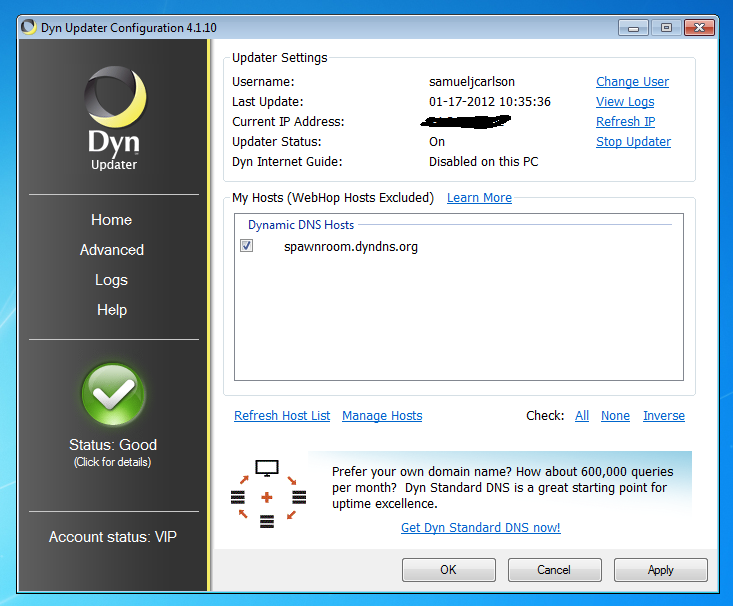

A window will open and after a short time, you should see messages indicating a successful IP change. In this example above you would create the entry " After you have created the file nf or copied it into the program directory, call the entry " start ddclient console" in the Windows start menu. You will later know whether your DynDNS client is working or not by checking if this IP changes to your dynamic one. When creating, there you may enter any IP like "192.168.0.1". = Your desired hostname - which you should have previously created under " DynA" in the DynDNS section on. USERNAME = the DynDNS-" Username" in the DynDNS-section at Please replace the placeholders with your entries beforehand: In the windows start menu you can also use the entry "Open nf in notepad" by right-clicking on "Run as administrator". The installation creates a section "ddclient" in the Windows start menu.Īfter the installation - during which you might enter any data - please copy the following text as " nf" into the directory where "ddclient" was installed. Or using as direct URL: Update-URL: 156ba6fa7f93bfd7&password= 5bc123a7100ef6a2& hostname= WindowsĪ simple and popular free DynDNS updater for Windows is ddclient. Please note: The parameter ' myip' is optional if not provided, the originating IP address is used automatically. Note: SSL is not supported by all devices, especially olders ones need to use. The input fields then have to be filled like this Then please choose "Custom" as the Dynamic DNS Provider. You have to enable "Dynamic DNS" with the checkbox. In the menu (web ui), you have to chose "Preferences" => "Internet" => "Dynamic DNS". As an example, this is the corresponding section of a Fritz!Box DSL router: Instead, when you create your DynDNS entry, you will be provided with special credentials which are only valid for those entries with the specific domain.Ī hardware device like a DSL router often is able to handle Dynamic DNS itself. Please note: The "username" and "password" referred to in this section are not identical to your standard credentials. The nameserver records have a TTL (time to live - defines the latency before changes become visible) of 60 seconds. This can be done by visiting ' DNS' in ' My Domains' in the menu 'Domains'.Īfter this, you have to configure your (DSL-) router or your Dynamic DNS software on your computer.Ĭurrently, there is a limit of 20 records per domain. To use Dynamic DNS records with, you have to create at least one Dynamic DNS record.Īdditionally, the Dynamic DNS feature has to be activated. A common use for it is running server software on a computer that has a dynamic IP address, as usually happens with many consumer Internet service providers. This makes it possible for other sites on the Internet to establish connections to the computer without needing to track the IP address themselves. The most common use for this is in allowing an Internet domain name to be assigned to a computer with a varying (dynamic) IP address.

Website FAQ » 1.9 Nameservice What is Dynamic DNS (DynDNS)?ĭynamic DNS (DynDNS) is a system that allows the domain name data held in a nameserver to be updated in real-time.


 0 kommentar(er)
0 kommentar(er)
